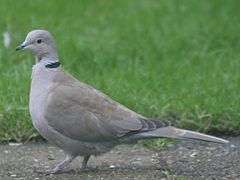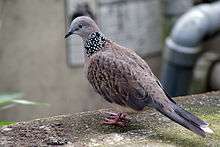Streptopelia
| Streptopelia | |
|---|---|
 | |
| The Eurasian collared dove (Streptopelia decaocto) is a typical and widespread member of the collared doves | |
| Scientific classification | |
| Kingdom: | Animalia |
| Phylum: | Chordata |
| Class: | Aves |
| Order: | Columbiformes |
| Family: | Columbidae |
| Genus: | Streptopelia Bonaparte, 1855 |
| Species | |
|
Around 15, see text. | |
Streptopelia is a genus of birds in the dove family. The name Streptopelia is from Ancient Greek streptos, "collar" and peleia, "dove".[1] These are mainly slim, small to medium-sized species. The upperparts tend to be pale brown, and the underparts are often a shade of pink. Many have a characteristic black-and-white patch on the neck, and monotonous cooing songs.
The heartland of this genus is Africa, but several species occur in tropical southern Asia. As a group, this genus is highly successful; many species are abundant in a range of habitats in the tropics, and two now have a much more extensive distribution.
The Eurasian collared dove, Streptopelia decaocto, naturally expanded out of its original range of the warmer temperate regions from south east Europe to Japan to colonise the rest of Europe, reaching as far west as Great Britain by 1960, and Ireland soon after. It has also been introduced into the US and, as of 1999 it had been reported from 22 states and was still spreading rapidly.
The spotted dove, S. chinensis (probably better placed in Spilopelia, see below), is an abundant and ubiquitous resident breeding bird in tropical southern Asia, but it has been introduced to the US, Hawaii, northern Indonesia, Australia and New Zealand.
A DNA sequence analysis has concluded that the genus consists of three distinct lineages. One contains the laughing dove and the spotted dove, which have long been recognized as having distinct morphology and behavior. The second group contains most of the other species, except the Madagascar turtle dove and the pink pigeon, which appear to be the surviving species of an endemic Madagascar/Mascarenes radiation and have at times been placed in other genera. The two-species lineages appear to be each other's closest relatives and cannot be firmly assigned to either Columba or Streptopelia (although overall they seem to be close to the latter). Thus, it might be best to split the two minor lineages off as distinct genera, namely Spilopelia for the first (which has priority over Stigmatopelia) and Nesoenas for the last.[2]
Species

Genus Streptopelia
- Eurasian collared dove or collared dove, Streptopelia decaocto
- Barbary dove Streptopelia risoria (domesticated; taxonomic status doubtful)
- African collared dove, Streptopelia roseogrisea
- European turtle dove Streptopelia turtur
- Oriental turtle dove Streptopelia orientalis
- Dusky turtle dove, Streptopelia lugens
- Adamawa turtle dove, Streptopelia hypopyrrha
- Island collared dove, Streptopelia bitorquata
- Philippine collared dove, Streptopelia dusumieri
- White-winged collared dove, Streptopelia reichenowi
- Mourning collared dove, Streptopelia decipiens
- Red-eyed dove, Streptopelia semitorquata
- Ring-necked dove, Streptopelia capicola
- Vinaceous dove, Streptopelia vinacea
- Red turtle dove, Streptopelia tranquebarica
The genera Spilopelia and Nesoenas are sometimes placed in Streptopelia, but this is debatable.
Genus Spilopelia
- Laughing dove Spilopelia senegalensis (sometimes separated as Stigmatopelia)
- Spotted dove Spilopelia chinensis
Genus Nesoenas
- Madagascar turtle dove, Nesoenas picturata
- †Rodrigues pigeon, Nesoenas rodericana - extinct (before 1690?)
- Pink pigeon, Nesoenas mayeri
- †Réunion pink pigeon, Nesoenas duboisi - extinct (c.1700)
References
- ↑ Jobling, James A (2010). The Helm Dictionary of Scientific Bird Names. London: Christopher Helm. p. 367. ISBN 978-1-4081-2501-4.
- ↑ Johnson, Kevin P.; de Kort, Selvino; Dinwoodey, Karen, Mateman, A. C.; ten Cate, Carel; Lessells, C. M. & Clayton, Dale H. (2001): A molecular phylogeny of the dove genera Streptopelia and Columba. Auk 118(4): 874-887.
| Wikimedia Commons has media related to Streptopelia. |
![]() Media related to Nesoenas at Wikimedia Commons
Media related to Nesoenas at Wikimedia Commons
![]() Media related to Spilopelia at Wikimedia Commons
Media related to Spilopelia at Wikimedia Commons